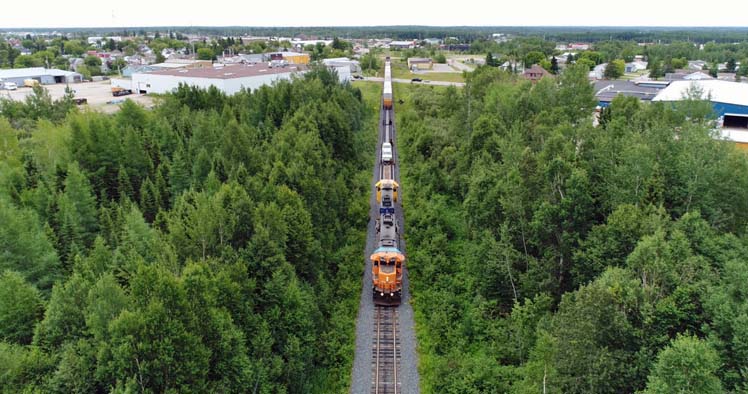

Leaders in Innovation
Ottawa Ontario - The Railway Association of Canada (RAC) hosts the Rail Government Interface on 15 May 2019 at the Delta Hotel, Ottawa,
where RAC members will be showcasing technologies that drive productivity and ensure that the transportation of goods and people by rail in Canada remains
safe.
Canada's rail industry has come a long way since The Last
Spike.
From helping to build our nation, rail is now a leading contributor to economic growth, and innovation is at the core of its operations.
Whether they're leveraging big data to prevent accidents, introducing Augmented Reality for training, or using aerial drones to assist with inspecting their
infrastructure, Canada's railways are constantly evolving to make their operations safer, more efficient, and built for the future.
Railway innovation has obvious benefits for Canada.
New technologies and techniques lead to efficiencies and safety improvements that enhance the efficiency of the rail network.
Each year, our country's freight railways move nearly 10 tonnes of goods for every Canadian.
Reliable rail transportation provides businesses with competitive transportation enabling them to better manage their costs which benefits
consumers.
In addition, each year more than 84 million people rely on railways to commute to and from work, travel between cities, and experience Canada's natural
beauty.
An efficient rail network encourages travellers to leave their cars at home and opt for a more sustainable mode of transportation.
Innovation enables railways to serve the needs of their customers and fulfill Canadians' passion for train travel.
Significant private investments drive our industry's culture of innovation.
Railways invest an average of 20 percent of their revenues back into their North American networks each year.
In 2019 alone, Canada's railways' capital investments will be a record $5.5 billion, of which a substantive portion will go towards innovative solutions to
improve every aspect of the business.
Any conversation about innovation among Canada's railways begins and ends with safety.
Canada's railways are the safest in North America, and investments in innovative safety technologies are an essential part of this achievement.
Over the years, new technologies have increased the frequency and improved the quality of safety inspections versus manual processes.
A comprehensive network of wayside inspection systems detects hard-to-see defects on trains travelling across Canada's 27,340 mile rail network.
These detectors gather and transmit data to railways, enabling them to proactively fix their equipment and infrastructure.
In addition, infrared technology is used to measure wheel temperatures and help railways identify issues with any of the wheels' components.
Fibre-optic technology also plays a role to evaluate the integrity of track, while ultrasonic devices can identify defects below the surface.
Rail companies are increasingly combining data from these formerly stand-alone systems to develop predictive analytics, and as a result, forecast trends to
enhance safety.
Virtual classrooms are also playing a role in evolving the way the rail industry trains its employees.
Recently, railways introduced Augmented Reality technology enabling first responders to view real-life scenarios in 3D.
In addition, 3D modelling of railway equipment allows trainees to learn important components of locomotives and railcars before they step into a rail
yard.
Innovation also drives the way freight railways work with customers to transport their products safely.
For example, an innovative process developed by one of Canada's railways turns bitumen, the heavy crude produced from Alberta's oil sands, into a solid pellet
by mixing and coating it with polymer.
These non-hazardous pellets, which don't burn, leak, or dissolve, will give Canadian producers a new, safe, shipping option in the future.
Investment in innovative technologies and techniques has resulted in continuous rail safety improvement.
Between 2008 and 2017, the safety record, the number of accidents relative to workload, among Canada's freight railways improved by 32 percent.
Similarly, passenger railways maintained a rate of less than one accident per million travellers for the sixth consecutive year in 2017.
Collaboration with research hubs across North America is also at the heart of innovation in the railway industry.
Working with organizations such as the Transportation Technology Centre Inc., the Canadian Rail Research Laboratory, and government departments such as the
National Research Council, and Transport Canada, provides the railway industry with best-in-class expertise today to identify the technology of
tomorrow.
The Railway Association of Canada will host its annual Rail Government Interface on 15 May 2019 at the Delta Hotel in Ottawa.
Innovation is the theme for this year's event and our members will be showcasing a number of technologies that drive productivity and ensure that the
transportation of goods and people by rail in Canada remains safe.
I invite you to come hear first hand from industry-leading experts about the extensive use of technology in the sector, and how innovation will drive their
operations in the future.
We look forward to seeing you on 15 May 2019.
Author unknown.
provisions in Section 29 of the Canadian
Copyright Modernization Act.

